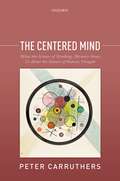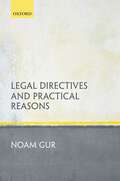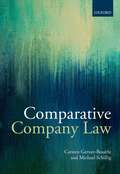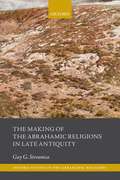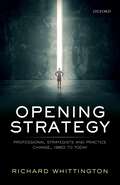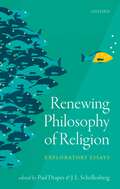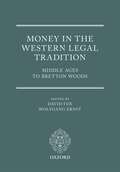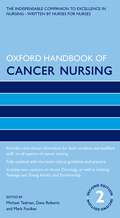- Table View
- List View
The Centered Mind: What the Science of Working Memory Shows Us About the Nature of Human Thought
by Peter CarruthersThe Centered Mind offers a new view of the nature and causal determinants of both reflective thinking and, more generally, the stream of consciousness. Peter Carruthers argues that conscious thought is always sensory-based, relying on the resources of the working-memory system. This system has been much studied by cognitive scientists. It enables sensory images to be sustained and manipulated through attentional signals directed at midlevel sensory areas of the brain. When abstract conceptual representations are bound into these images, we consciously experience ourselves as making judgments or arriving at decisions. Thus one might hear oneself as judging, in inner speech, that it is time to go home, for example. However, our amodal (non-sensory) propositional attitudes are never actually among the contents of this stream of conscious reflection. Our beliefs, goals, and decisions are only ever active in the background of consciousness, working behind the scenes to select the sensory-based imagery that occurs in working memory. They are never themselves conscious. Drawing on extensive knowledge of the scientific literature on working memory and related topics, Carruthers builds an argument that challenges the central assumptions of many philosophers. In addition to arguing that non-sensory propositional attitudes are never conscious, he also shows that they are never under direct intentional control. Written with his usual clarity and directness, The Centered Mind will be essential reading for all philosophers and cognitive scientists interested in the nature of human thought processes.
The Centered Mind: What the Science of Working Memory Shows Us About the Nature of Human Thought
by Peter CarruthersThe Centered Mind offers a new view of the nature and causal determinants of both reflective thinking and, more generally, the stream of consciousness. Peter Carruthers argues that conscious thought is always sensory-based, relying on the resources of the working-memory system. This system has been much studied by cognitive scientists. It enables sensory images to be sustained and manipulated through attentional signals directed at midlevel sensory areas of the brain. When abstract conceptual representations are bound into these images, we consciously experience ourselves as making judgments or arriving at decisions. Thus one might hear oneself as judging, in inner speech, that it is time to go home, for example. However, our amodal (non-sensory) propositional attitudes are never actually among the contents of this stream of conscious reflection. Our beliefs, goals, and decisions are only ever active in the background of consciousness, working behind the scenes to select the sensory-based imagery that occurs in working memory. They are never themselves conscious. Drawing on extensive knowledge of the scientific literature on working memory and related topics, Carruthers builds an argument that challenges the central assumptions of many philosophers. In addition to arguing that non-sensory propositional attitudes are never conscious, he also shows that they are never under direct intentional control. Written with his usual clarity and directness, The Centered Mind will be essential reading for all philosophers and cognitive scientists interested in the nature of human thought processes.
New Work on Speech Acts
Speech-act theory is the interdisciplinary study of the wide range of things we do with words. Originally stemming from the influential work of twentieth-century philosophers, including J. L. Austin and Paul Grice, recent years have seen a resurgence of work on the topic. On one hand, a new generation of linguists, philosophers, and cognitive scientists have made impressive progress toward reverse-engineering the psychological underpinnings that allow us to do so much with language. Meanwhile, speech-act theory has been used to enrich our understanding of pressing social issues that include freedom of speech, racial slurs, and the duplicity of political discourse. This volume presents fourteen new essays by many of the philosophers and linguists who have led this resurgence. The topics span a methodological range that includes formal semantics and pragmatics, foundational issues about the nature of linguistic representation, and work on a variety of forms of indirect and/or uncooperative speech that occupies the intersection of the philosophy of language, ethics, and political philosophy. Several of the contributions demonstrate the benefits of integrating the methodologies and perspectives of these literatures. The essays are framed by a comprehensive introductory survey of the contemporary literature written by the editors.
New Work on Speech Acts
by Daniel Fogal Daniel W. Harris Matt MossSpeech-act theory is the interdisciplinary study of the wide range of things we do with words. Originally stemming from the influential work of twentieth-century philosophers, including J. L. Austin and Paul Grice, recent years have seen a resurgence of work on the topic. On one hand, a new generation of linguists, philosophers, and cognitive scientists have made impressive progress toward reverse-engineering the psychological underpinnings that allow us to do so much with language. Meanwhile, speech-act theory has been used to enrich our understanding of pressing social issues that include freedom of speech, racial slurs, and the duplicity of political discourse. This volume presents fourteen new essays by many of the philosophers and linguists who have led this resurgence. The topics span a methodological range that includes formal semantics and pragmatics, foundational issues about the nature of linguistic representation, and work on a variety of forms of indirect and/or uncooperative speech that occupies the intersection of the philosophy of language, ethics, and political philosophy. Several of the contributions demonstrate the benefits of integrating the methodologies and perspectives of these literatures. The essays are framed by a comprehensive introductory survey of the contemporary literature written by the editors.
Courts and Comparative Law
While the role of comparative law in the courts was previously only an exception, foreign sources are now increasingly becoming a source of law in regular use in supreme and constitutional courts. There is considerable variation between the practices of courts and the role of comparative law, and methods remain controversial. In the US, the issue has been one of intense public debate and it is still one of the major dividing issues in the discussion about the role of the courts. Contributing to the existing discussion of the use of comparative law in the courts, this book provides an inclusive, coherent, and practical analysis of the relevant law and jurisprudence in comparative law in the courts. It examines the consequences for court procedures and the form of judgments, as well as how foreign sources are drawn upon in private international law, European law, administrative law, and constitutional law as well as before general courts. The book also includes case studies of comparative law used in particular spheres of the law, such as tort law and consumer law. Written by practising judges and lawyers as well as leading academics, this book serves as a central reference point concerning the role of comparative law before the courts.
Courts and Comparative Law
by Mads Andenas Duncan FairgrieveWhile the role of comparative law in the courts was previously only an exception, foreign sources are now increasingly becoming a source of law in regular use in supreme and constitutional courts. There is considerable variation between the practices of courts and the role of comparative law, and methods remain controversial. In the US, the issue has been one of intense public debate and it is still one of the major dividing issues in the discussion about the role of the courts. Contributing to the existing discussion of the use of comparative law in the courts, this book provides an inclusive, coherent, and practical analysis of the relevant law and jurisprudence in comparative law in the courts. It examines the consequences for court procedures and the form of judgments, as well as how foreign sources are drawn upon in private international law, European law, administrative law, and constitutional law as well as before general courts. The book also includes case studies of comparative law used in particular spheres of the law, such as tort law and consumer law. Written by practising judges and lawyers as well as leading academics, this book serves as a central reference point concerning the role of comparative law before the courts.
Legal Directives and Practical Reasons
by Noam GurThis book investigates law's interaction with practical reasons. What difference can legal requirements-e.g. traffic rules, tax laws, or work safety regulations-make to normative reasons relevant to our action? Do they give reasons for action that should be weighed among all other reasons? Or can they, instead, exclude and take the place of some other reasons? The book critically examines some of the existing answers and puts forward an alternative understanding of law's interaction with practical reasons. At the outset, two competing positions are pitted against each other: Joseph Raz's view that (legitimate) legal authorities have pre-emptive force, namely that they give reasons for action that exclude some other reasons; and an antithesis, according to which law-making institutions (even those that meet prerequisites of legitimacy) can at most provide us with reasons that compete in weight with opposing reasons for action. These two positions are examined from several perspectives, such as justified disobedience cases, law's conduct-guiding function in contexts of bounded rationality, and the phenomenology associated with authority. It is found that, although each of the above positions offers insight into the conundrum at hand, both suffer from significant flaws. These observations form the basis on which an alternative position is put forward and defended. According to this position, the existence of a reasonably just and well-functioning legal system constitutes a reason that fits neither into a model of ordinary reasons for action nor into a pre-emptive paradigm-it constitutes a reason to adopt an (overridable) disposition that inclines its possessor towards compliance with the system's requirements. Runner-up for the Peter Birks Book Prize for Outstanding Legal Scholarship 2019.
Legal Directives and Practical Reasons
by Noam GurThis book investigates law's interaction with practical reasons. What difference can legal requirements-e.g. traffic rules, tax laws, or work safety regulations-make to normative reasons relevant to our action? Do they give reasons for action that should be weighed among all other reasons? Or can they, instead, exclude and take the place of some other reasons? The book critically examines some of the existing answers and puts forward an alternative understanding of law's interaction with practical reasons. At the outset, two competing positions are pitted against each other: Joseph Raz's view that (legitimate) legal authorities have pre-emptive force, namely that they give reasons for action that exclude some other reasons; and an antithesis, according to which law-making institutions (even those that meet prerequisites of legitimacy) can at most provide us with reasons that compete in weight with opposing reasons for action. These two positions are examined from several perspectives, such as justified disobedience cases, law's conduct-guiding function in contexts of bounded rationality, and the phenomenology associated with authority. It is found that, although each of the above positions offers insight into the conundrum at hand, both suffer from significant flaws. These observations form the basis on which an alternative position is put forward and defended. According to this position, the existence of a reasonably just and well-functioning legal system constitutes a reason that fits neither into a model of ordinary reasons for action nor into a pre-emptive paradigm-it constitutes a reason to adopt an (overridable) disposition that inclines its possessor towards compliance with the system's requirements. Runner-up for the Peter Birks Book Prize for Outstanding Legal Scholarship 2019.
Comparative Company Law
by Carsten Gerner-Beuerle Michael Anderson SchilligComparative Company Law provides a systematic and coherent exposition of company law across jurisdictions, augmented by extracts taken from key judgments, legislation, and scholarly works. It provides an overview of the legal framework of company law in the US, the UK, Germany, and France, as well as the legislative measures adopted by the EU and the relevant case law of the Court of Justice. The comparative analysis of legal frameworks is firmly grounded in legal history and legal and economic theory and bolstered by numerous extracts (including extracts in translation) that offer the reader an invaluable insight into how the law operates in context. The book is an essential guide to how company law cuts across borders, and how different jurisdictions shape the corporate lifespan from its formation by way of incorporation to its demise (corporate insolvency) and eventual dissolution. In addition, it offers an introduction to the nature of the corporation, the framework of EU company law, incorporation and corporate representation, agency problems in the firm, rights of stakeholders and shareholders, neutrality and defensive measures in corporate control transactions, legal capital, piercing the corporate veil, and corporate insolvency and restructuring law.
Comparative Company Law
by Carsten Gerner-Beuerle Michael Anderson SchilligComparative Company Law provides a systematic and coherent exposition of company law across jurisdictions, augmented by extracts taken from key judgments, legislation, and scholarly works. It provides an overview of the legal framework of company law in the US, the UK, Germany, and France, as well as the legislative measures adopted by the EU and the relevant case law of the Court of Justice. The comparative analysis of legal frameworks is firmly grounded in legal history and legal and economic theory and bolstered by numerous extracts (including extracts in translation) that offer the reader an invaluable insight into how the law operates in context. The book is an essential guide to how company law cuts across borders, and how different jurisdictions shape the corporate lifespan from its formation by way of incorporation to its demise (corporate insolvency) and eventual dissolution. In addition, it offers an introduction to the nature of the corporation, the framework of EU company law, incorporation and corporate representation, agency problems in the firm, rights of stakeholders and shareholders, neutrality and defensive measures in corporate control transactions, legal capital, piercing the corporate veil, and corporate insolvency and restructuring law.
The Space of Culture: Towards a Neo-Kantian Philosophy of Culture (Cohen, Natorp, and Cassirer)
by Sebastian LuftSebastian Luft presents and defends the philosophy of culture championed by the Marburg School of Neo-Kantianism. Following a historical trajectory from Hermann Cohen to Paul Natorp and through to Ernst Cassirer, this book makes a systematic case for the viability and attractiveness of a philosophical culture in a transcendental vein, in the manner in which the Marburgers intended to broaden Kant's approach. In providing a philosophical study of culture, Luft adheres to important Kantian tenets while addressing empirical studies of culture. The Space of Culture culminates in an exploration of Cassirer's Philosophy of Symbolic Forms, and argues for the extent to which Cassirer's thought was firmly rooted in the Marburg School, despite his originality. At the same time, it shows how Cassirer opened up the philosophical study of culture to new horizons, making it attractive for contemporary philosophy.
The Space of Culture: Towards a Neo-Kantian Philosophy of Culture (Cohen, Natorp, and Cassirer)
by Sebastian LuftSebastian Luft presents and defends the philosophy of culture championed by the Marburg School of Neo-Kantianism. Following a historical trajectory from Hermann Cohen to Paul Natorp and through to Ernst Cassirer, this book makes a systematic case for the viability and attractiveness of a philosophical culture in a transcendental vein, in the manner in which the Marburgers intended to broaden Kant's approach. In providing a philosophical study of culture, Luft adheres to important Kantian tenets while addressing empirical studies of culture. The Space of Culture culminates in an exploration of Cassirer's Philosophy of Symbolic Forms, and argues for the extent to which Cassirer's thought was firmly rooted in the Marburg School, despite his originality. At the same time, it shows how Cassirer opened up the philosophical study of culture to new horizons, making it attractive for contemporary philosophy.
The Making of the Abrahamic Religions in Late Antiquity (Oxford Studies in the Abrahamic Religions)
by Guy G. StroumsaThis book presents how ancient Christianity must be understood from the viewpoint of the history of religions in late antiquity. The continuation of biblical prophecy runs like a thread from Jesus through Mani to Muhammad. And yet this thread, arguably the single most important characteristic of the Abrahamic movement, often remains outside the mainstream, hidden, as it were, since it generates heresy. The figures of the Gnostic, the Holy man, and the mystic are all sequels of the Israelite prophet. They reflect a mode of religiosity that is characterized by high intensity. It is centripetal and activist by nature and emphasizes sectarianism and polemics, esoteric knowledge, or gnosis and charisma. The other mode of religiosity, obviously much more common than the first one, is centrifugal and irenic. It favours an ecumenical attitude, contents itself with a widely shared faith, or pistis, and reflects, in Weberian parlance, the routinisation of the new religious movement. This is the mode of priests and bishops, rather than that of martyrs and holy men. These two main modes of religion, high versus low intensity, exist simultaneously, and cross the boundaries of religious communities. They offer a tool permitting us to follow the transformations of religion in late antiquity in general, and in ancient Christianity in particular, without becoming prisoners of the traditional categories of Patristic literature. Through the dialectical relationship between these two modes of religiosity, one can follow the complex transformations of ancient Christianity in its broad religious context.
The Making of the Abrahamic Religions in Late Antiquity (Oxford Studies in the Abrahamic Religions)
by Guy G. StroumsaThis book presents how ancient Christianity must be understood from the viewpoint of the history of religions in late antiquity. The continuation of biblical prophecy runs like a thread from Jesus through Mani to Muhammad. And yet this thread, arguably the single most important characteristic of the Abrahamic movement, often remains outside the mainstream, hidden, as it were, since it generates heresy. The figures of the Gnostic, the Holy man, and the mystic are all sequels of the Israelite prophet. They reflect a mode of religiosity that is characterized by high intensity. It is centripetal and activist by nature and emphasizes sectarianism and polemics, esoteric knowledge, or gnosis and charisma. The other mode of religiosity, obviously much more common than the first one, is centrifugal and irenic. It favours an ecumenical attitude, contents itself with a widely shared faith, or pistis, and reflects, in Weberian parlance, the routinisation of the new religious movement. This is the mode of priests and bishops, rather than that of martyrs and holy men. These two main modes of religion, high versus low intensity, exist simultaneously, and cross the boundaries of religious communities. They offer a tool permitting us to follow the transformations of religion in late antiquity in general, and in ancient Christianity in particular, without becoming prisoners of the traditional categories of Patristic literature. Through the dialectical relationship between these two modes of religiosity, one can follow the complex transformations of ancient Christianity in its broad religious context.
Opening Strategy: Professional Strategists and Practice Change, 1960 to Today
by Richard WhittingtonStrategy is becoming more 'open' - more transparent and more inclusive. Opening Strategy tells the story of how corporate strategists and strategy consultants have worked since the middle of the last century to open up the strategy process. First strategic planning, then strategic management, and now 'open strategy' have all brought more people into the strategy process and provided more strategic information, for the benefit of both business and society at large. Informed by interviews with corporate strategists and consultants at leading firms such as General Electric and McKinsey & Co, and drawing on the historical archives of strategy's pioneers, this book provides vivid insights into the trials and tribulations of practice change in the strategy profession. Above all, it stresses the hard work of the little recognized and sometimes eccentric individuals who have been leaders in practice change. By building on a wide range of illustrations, covering both successes and failures, the book draws out general lessons for practice innovation in strategy. Those studying the topic will be able to set standard strategy techniques in historical and social context and develop new areas for investigation, while practising executives and consultants should gain a sense of how to innovate in strategy - and how not to.
Renewing Philosophy of Religion: Exploratory Essays
This book is animated by a shared conviction that philosophy of religion needs to change: thirteen new essays suggest why and how. The first part of the volume explores possible changes to the focus of the field. The second part focuses on the standpoint from which philosophers of religion should approach their field. In the first part are chapters on how an emphasis on faith distorts attempts to engage non-western religious ideas; on how philosophers from different traditions might collaborate on common interests; on why the common presupposition of ultimacy leads to error; on how new religious movements feed a naturalistic philosophy of religion; on why a focus on belief and a focus on practice are both mistaken; on why philosophy's deep axiological concern should set much of the field's agenda; and on how the field might contribute to religious evolution. The second part includes a qualitative analysis of the standpoint of fifty-one philosophers of religion, and also addresses issues about humility needed in continental philosophy of religion; about the implausibility of claiming that one's own worldview is uniquely rational; about the Moorean approach to religious epistemology; about a Spinozan middle way between 'insider' and 'outsider' perspectives; and about the unorthodox lessons we could learn from scriptures like the book of Job if we could get past the confessional turn in recent philosophy of religion.The goal of the volume is to identify new paths for philosophers of religion that are distinct from those travelled by theologians and other scholars of religion.
The Cognitive Penetrability of Perception: New Philosophical Perspectives
According to the cognitive penetrability hypothesis, our beliefs, desires, and possibly our emotions literally affect how we see the world. This book elucidates the nature of the cognitive penetrability and impenetrability hypotheses, assesses their plausibility, and explores their philosophical consequences. It connects the topic's multiple strands (the psychological findings, computationalist background, epistemological consequences of cognitive architecture, and recent philosophical developments) at a time when the outcome of many philosophical debates depends on knowing whether and how cognitive states can influence perception. All sixteen chapters were written especially for the book. The first chapters provide methodological and conceptual clarification of the topic and give an account of the relations between penetrability, encapsulation, modularity, and cross-modal interactions in perception. Assessments of psychological and neuroscientific evidence for cognitive penetration are given by several chapters. Most of the contributions analyse the impact of cognitive penetrability and impenetrability on specific philosophical topics: high-level perceptual contents, the epistemological consequences of penetration, nonconceptual content, the phenomenology of late perception, metacognitive feelings, and action. The book includes a comprehensive introduction which explains the history of the debate, its key technical concepts (informational encapsulation, early and late vision, the perception-cognition distinction, hard-wired perceptual processing, perceptual learning, theory-ladenness), and the debate's relevance to current topics in the philosophy of mind and perception, epistemology, and philosophy of psychology.
Money in the Western Legal Tradition: Middle Ages to Bretton Woods
Monetary law is essential to the functioning of private transactions and international dealings by the state: nearly every legal transaction has a monetary aspect. Money in the Western Legal Tradition presents the first comprehensive analysis of Western monetary law, covering the civil law and Anglo-American common law legal systems from the High Middle Ages up to the middle of the 20th century. Weaving a detailed tapestry of the changing concepts of money and private transactions throughout the ages, the contributors investigate the special contribution made by legal scholars and practitioners to our understanding of money and the laws that govern it. Divided in five parts, the book begins with the coin currency of the Middle Ages, moving through the invention of nominalism in the early modern period to cashless payment and the rise of the banking system and paper money, then charting the progression to fiat money in the modern era. Each part commences with an overview of the monetary environment for the historical period written by an economic historian or numismatist. These are followed by chapters describing the legal doctrines of each period in civil and common law. Each section contains examples of contemporary litigation or statute law which engages with the distinctive issues affecting the monetary law of the period. This interdisciplinary approach reveals the distinctive conception of money prevalent in each period, which either facilitated or hampered the implementation of economic policy and the operation of private transactions.
Money in the Western Legal Tradition: Middle Ages to Bretton Woods
by David Fox Wolfgang ErnstMonetary law is essential to the functioning of private transactions and international dealings by the state: nearly every legal transaction has a monetary aspect. Money in the Western Legal Tradition presents the first comprehensive analysis of Western monetary law, covering the civil law and Anglo-American common law legal systems from the High Middle Ages up to the middle of the 20th century. Weaving a detailed tapestry of the changing concepts of money and private transactions throughout the ages, the contributors investigate the special contribution made by legal scholars and practitioners to our understanding of money and the laws that govern it. Divided in five parts, the book begins with the coin currency of the Middle Ages, moving through the invention of nominalism in the early modern period to cashless payment and the rise of the banking system and paper money, then charting the progression to fiat money in the modern era. Each part commences with an overview of the monetary environment for the historical period written by an economic historian or numismatist. These are followed by chapters describing the legal doctrines of each period in civil and common law. Each section contains examples of contemporary litigation or statute law which engages with the distinctive issues affecting the monetary law of the period. This interdisciplinary approach reveals the distinctive conception of money prevalent in each period, which either facilitated or hampered the implementation of economic policy and the operation of private transactions.
Oxford Handbook of Humanitarian Medicine (Oxford Medical Handbooks)
by Amy S. KravitzThe Oxford Handbook of Humanitarian Medicine is a practical guide covering all aspects of the provision of care in humanitarian situations and complex emergencies. It includes evidence-based clinical guidance, aimed specifically at resource limited situations, as well as essential non-clinical information relevant for people working in field operations and development. The handbook provides clear recommendations, from the experts, on the unique challenges faced by health providers in humanitarian settings including clinical presentations for which conventional medical training offers little preparation. It provides guidance for syndromic management approaches, and includes practical guidance on the integration of context specific mental health care. The handbook goes beyond the clinical domain, however, and also provides detailed information on the contextual issues involved in humanitarian operations, including health systems design, priorities in displacement, security and logistics. It outlines the underlying drivers at play in humanitarian settings, including economics, gender based inequities, and violence, guiding the reader through the epidemiological approaches in varied scenarios. It details the relevance of international law, and its practical application in complex emergencies, and covers the changing picture of humanitarian operations, with increasingly complicated and chaotic contexts and the escalation of violence against humanitarian providers and facility. The Oxford Handbook of Humanitarian Medicine draws on the accumulated experience of humanitarian practitioners from a variety of disciplines and contexts to provide an easily accessible source of information to guide the reader through the complicated scenarios found in humanitarian settings.
Oxford Handbook of Infectious Diseases and Microbiology (Oxford Medical Handbooks)
by Ed Moran Estée Török Fiona CookeFully reviewed and revised for its second edition, the Oxford Handbook of Infectious Diseases and Microbiology maintains its position as the must-have guide to all aspects of infectious diseases and microbiology. Reflecting the current approach to joint postgraduate training programmes, the handbook takes an integrated approach to both subjects. It covers the basic principles of bacteriology and virology, along with specific guidance on individual diseases and conditions, all in the accessible Oxford Handbook style. Now including new topics on important subjects such as microbiology specimen collection, commonly used media, molecular diagnostics, and antimicrobials in pregnancy, as well as incorporating new guidelines from WHO, NICE, and BASHH among others, this handbook ensures that the informaiton you need is accessible, clear, and easy-to-understand. Practical and comprehensive, this handbook includes coverage of National Frameworks and current legislation, together with information on topical issues such as bioterrorism and preventative medicine. Fully reviewed by specialist senior readers, and with useful links to up-to-date clinical information and online resources, this is an important addition to the Oxford Handbook Series.
Oxford Handbook of Cancer Nursing (Oxford Handbooks in Nursing)
by Mike Tadman, Dave Roberts, and Mark FoulkesThis second edition of the Oxford Handbook of Cancer Nursing is an essential aid to the practising cancer nurse. It provides a quick reference to the key issues in cancer nursing, and a concise and systematic account of all of the main areas of cancer nursing practice. Filled with key tips and reflection points, each chapter supports professional development for the reader. The patient, their family, and the experience of cancer are at the heart of this handbook. For the new edition there is a greater focus on survivorship, drawing on recent developments in the area. The Oxford Handbook of Cancer Nursing promotes a multidisciplinary approach to cancer care, with references to current best evidence and the latest developments in treatment. Detailed guidance on complex aspects of care are outlined, integrating both psychosocial and physical care to better treat the whole patient. Written by experienced nurses, the book is laid out to enable quick access to precise, targeted information on the vast majority of potential clinical scenarios.
Oxford Handbook of Surgical Nursing (Oxford Handbooks in Nursing)
by Alison Smith, Maria Kisiel and Mark RadfordConcise, practical, and packed full of clinical information, the Oxford Handbook of Surgical Nursing is the essential resource for all those working in nursing practice surgery and its sub-specialties. Easily-accessible, this handbook provides all of the information and practical advice needed to care effectively and professionally for surgical patients. This handbook provides a thorough introduction to the principles and practice of the care of patients undergoing the range of surgical procedures. It covers all of the core elements of surgical care from point of diagnosis, through to discharge and rehabilitation. The Oxford Handbook of Surgical Nursing provides clinical knowledge and skills for managing complex cases in the hospital or clinic. This guide will assist the reader in understanding the core role of the surgical nurse within the modern surgical team, to plan, implement and evaluate patient care delivery, and to manage complications arising from surgery. Evidence-based, and following the latest national guidelines, you can be sure this will be an indispensable companion, for all nurses, whether new to the specialty, or more experienced in surgical care.
Oxford Handbook for Medical School (Oxford Medical Handbooks)
by Kapil SugandMedical school is full of unfamiliar and often frightening experiences for students. In the first year, a student must move away from home, balance personal finances, assimilate large volumes of information, learn practical skills, pass high stakes exams, and face a range of unique experiences. The Oxford Handbook for Medical School provides an essential, practical guide for all students, whether you have just received your offer, you're eager to succeed on the wards, or you're about to start your final exams. This handbook includes quick-access summaries covering the crucial information for your preclinical years and for each clinical specialty. With bullet lists of the key information you need to know, and helpful mnemonics throughout, this is a concise yet thoroughly comprehensive guide. Written by a team of recent students, now successfully graduated and embarking on their careers, this book will be your closest companion right up to graduation. More than a survival guide, it will help you navigate the bewildering range of opportunities medical school offers, showing you how to make the most of your time, so you are fully prepared for your future career.
Oxford Handbook of Operative Surgery (Oxford Medical Handbooks)
by Anil Agarwal, Neil Borley and Greg McLatchieFor its third edition, this handbook has been fully revised and rewritten for the renowned Oxford Medical Handbook series. Including comprehensive coverage of all common surgical specialties and operations, it fully integrates practical advice on pre-operative procedure, equipment, step-by step surgical procedures, common techniques, and tips and tricks from over thirty experienced specialist surgeons. With over three hundred detailed practical diagrams and images to assist your understanding and packed with step-by-step, concise, and clear expert advice, you can be confident that this handbook will be your essential guide to all aspects of operative surgery. Providing an overview of modern operative surgical practice the Oxford Handbook of Operative Surgery will enable all surgeons, whether they are just starting out or posessing many years' experience, to prepare fully and be confident in observing, assisting or performing across the wide variety of surgical operations. Fully up to date and reflecting current practice and guidelines, it provides an essential complement to the highly successful Oxford Handbook of Clinical Surgery.
